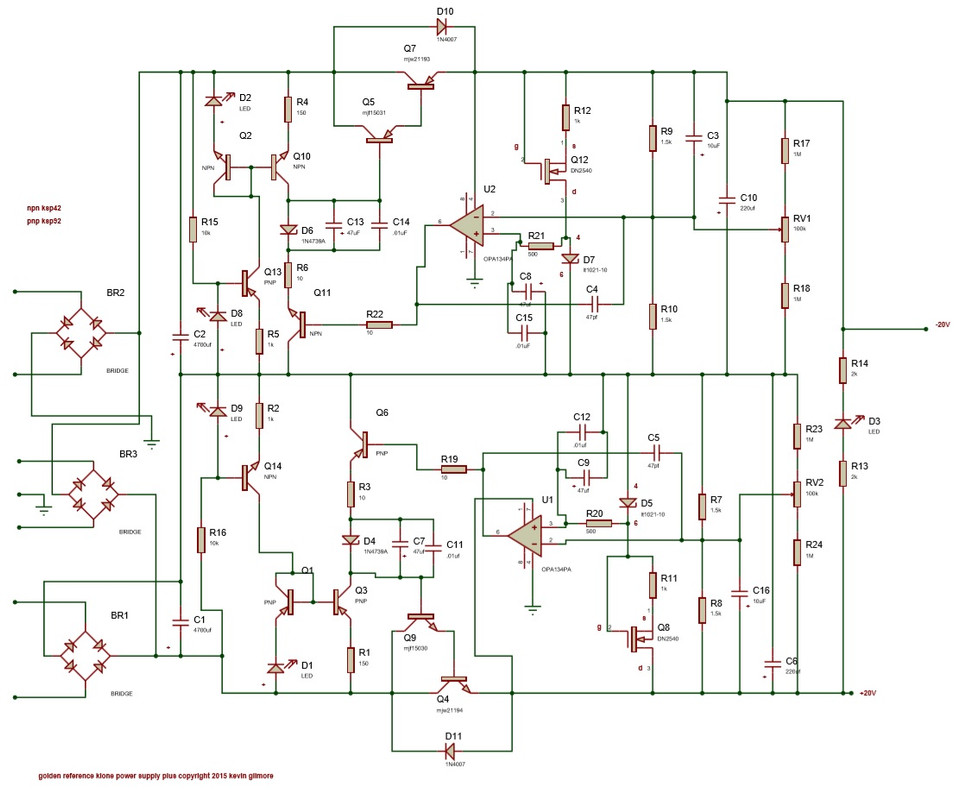@jan.didden
Thank you for your answer. I received the BPPBP board last week, and now need to decide which power supply and potentionmeter to use for this project.
Today, I find a schematic for one PSU, which was called GRLV and developed by Kevin Gilmore based on Walt Jung's design.
I would be very grateful if someone with deep knowledge like you could comment some opinion about it

This design deserves the price for putting the maximum amount of components into a PS.
It will work without a doubt, but a Jung-Didden PS or a silent switcher will be at least as good.
Hans
What regulator do you use in your BPPBP?
Both sq225917 and myself use the Hypex regs with our DC supplies.
I use Vishay P9 (conductive plastic) with excellent results. The pot specified in the article (PTD902) also works well but gives a little more noise.
I've tried half a dozen pots started with the bom part, tried khozmo ladder and shunt stepped pots, ended up with a tkd 601. Which is better than all of them. Less hassle than the rc Khozmo pots which all ended up picking up noise and better channel balance than any other pot I tried, 1% across the full range.
@sq225917,@alexcp : Thanks for your input
@sq225917
Since the TKD 2CP-601 is log potentiometer, I would like to ask how much you can rotate it in your BPPBP.
@sq225917
Since the TKD 2CP-601 is log potentiometer, I would like to ask how much you can rotate it in your BPPBP.
Built this great preamp, but the actual volume control occurs in a very small radius of the pot. The standard pot as per BOM seem to have a large amount of channel mismatch, also.
What are my options for having a wider range of volume control with equal attention (I know it doesn't actually attenuate the audio signal)?
What are my options for having a wider range of volume control with equal attention (I know it doesn't actually attenuate the audio signal)?
Built this great preamp, but the actual volume control occurs in a very small radius of the pot. The standard pot as per BOM seem to have a large amount of channel mismatch, also.
What are my options for having a wider range of volume control with equal attention (I know it doesn't actually attenuate the audio signal)?
If you can track down one of Han's Volume Control boards, I have modified DimDim's LaScala relay attenuator code to utilize it with an Arduino Nano(any Arduino really). It has 64 x 1db steps. Volume matching only limited by the tolerance of the resistors, and how much time you want to spend matching them..
Now that's more like it. Any of Han's boards still available?If you can track down one of Han's Volume Control boards, I have modified DimDim's LaScala relay attenuator code to utilize it with an Arduino Nano(any Arduino really). It has 64 x 1db steps. Volume matching only limited by the tolerance of the resistors, and how much time you want to spend matching them..
Now that's more like it. Any of Han's boards still available?
I asked him just a few days ago and he said no, unfortunately. I am also interested in picking one up.
If no one has any to spare, and with Han's permission, I could do a small run. I have the Gerbers.
I have a few of his Input controller boards too. Still working out the details on getting them working with the arduino. I'm having issues with the rotary encoder pushbutton code, to control everything via one control. I may just go back to using a selector switch and an I2C chip..
There are 2 versions for the volume control board
1) manually controlled by a rotary encoder, giving 16 steps of 2 dB each
2) a remote controlled version giving 32 steps of 1 dB.
For this second version there is also an input extension board increasing the number of inputs to 4 and also providing a tape-out connector.
I have no PCB's, but the Gerbers are freely available and can be used to produce as many copies as you like.
Hans
1) manually controlled by a rotary encoder, giving 16 steps of 2 dB each
2) a remote controlled version giving 32 steps of 1 dB.
For this second version there is also an input extension board increasing the number of inputs to 4 and also providing a tape-out connector.
I have no PCB's, but the Gerbers are freely available and can be used to produce as many copies as you like.
Hans
There are 2 versions for the volume control board
1) manually controlled by a rotary encoder, giving 16 steps of 2 dB each
2) a remote controlled version giving 32 steps of 1 dB.
For this second version there is also an input extension board increasing the number of inputs to 4 and also providing a tape-out connector.
I have no PCB's, but the Gerbers are freely available and can be used to produce as many copies as you like.
Hans
Hey Hans, The remote version has 6 relays which should give 64 steps right?
- Home
- Source & Line
- Analog Line Level
- BPPBP - Bruno Putzey's Purist Balanced Preamp (well a balanced volume control really)